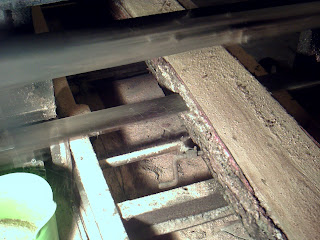During my last project I needed to mark a line out to determine the area for the base plate of the steam engine. I had already made the rabbets on the foundation for the display case. This resulted in that I couldn't use my Veritas marking gauge since the fence is too high.
I found my old scratch type Danish marking gauge. It can also be used as a mortising gauge, since it has got two points that are individually adjustable.
Brian Eve pointed out he would like some more information about it, so here is a little portion of unnecessary knowledge:
The brand is JPBO which is an abbreviation of: Johan P Bendixen, Odense. I guess that the founders middle name was Peter (a common name), but I am not sure. The company was positioned in Odense which is the 3rd largest city in Denmark. Normally this brand is associated with planes rather than marking gauges, so here is a small description of this Danish contribution to the world of planes:
This company is mainly known for their production of wooden bodied planes. These planes are still fairly common, since they were supplied for a lot of schools for Sløjd classes (sloyd / woodworking).
The company went bankrupt in 1992, but I don't think that they produced planes that late. My guess is, that they stopped the production of planes sometime in the late 1970'ies
The planes are typically made out of beech, but some of the fancier ones also have some exotic wood in them.
Since we don't have any steel production in Denmark, the blades were imported from the worlds leading country concerning high quality steel: Sweden. And not only from this country, but also from the worlds absolute finest producer of chisels and plane irons: Erik Anton Berg of Eskilstuna. (please note that parts of this paragraph are my points of view, and not necessarily the truth, the whole truth and nothing but the truth). I am in no way affiliated with E.A. Berg or any of its subsidiaries etc. bla. bla. bla.
It seems that the irons for the smaller planes weren't necessarily from E.A. Berg, as one of my specialty planes has got a British iron from Sheffield (I can't remember the manufacturer).
My 24" wooden jointer, with a 63 mm iron (2.5")
Close up of the lamination.
The jointer sadly has a crack on one side besides the mouth, I guess that some earlier owner smashed the wedge in too hard. It doesn't affect the function of the plane as far as I have noticed though.
JPBO is cast into the cap iron, and the width of the blade is stamped on the back of the plane.
My wooden smoothing plane with an adjustable mouth.
Close up of the adjustable mouth. The sole of the plane is of a hard exotic wood.
If you look carefully, you will see that some jerk (me) ground the iron to a round shape to be able to use the plane as a scrub plane. I can't really explain what went through my mind that day, since I have other less delicate wooden planes that I could have converted. I can just say that I am sorry.
A JPBO plane that I have never used.
Front view of the plane.
I have never used this plane, since I have absolutely no clue as to what it should be used for. It was placed in a tool cabinet that my father bought at a second hand shop. It has been in there since it was new, and the guy who made the cabinet is a trained cabinetmaker. The width of the blade is 20 mm.
Another specialty plane from JPBO.
Front view of the plane.
My guess is that this plane is used to make a 30 degree chamfer on both sides where two boards meet. e.g. floor boards. But if there are someone out there with more specific knowledge, please enlighten us all.
The marking gauge that caught Brian's eye.
The wear surface is covered with a plate of brass.
I prefer the Veritas marking gauge, but one advantage of this gauge is that you can turn the rods containing the points 90 degrees, enabling you to use the marking gauge on the side instead of end wise.








































